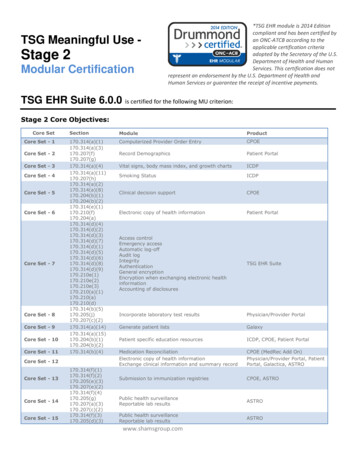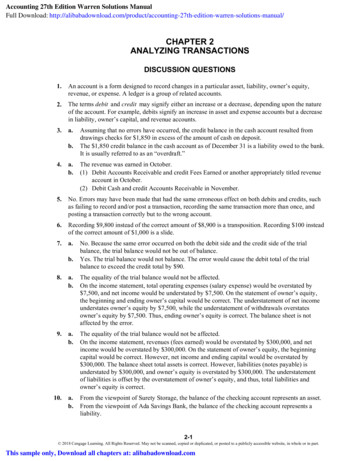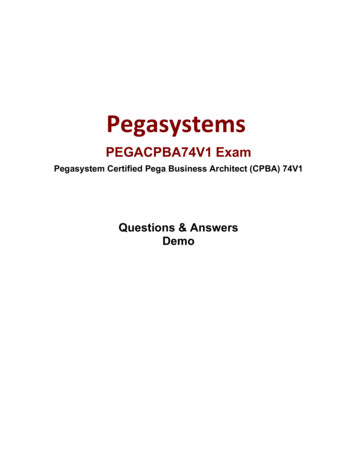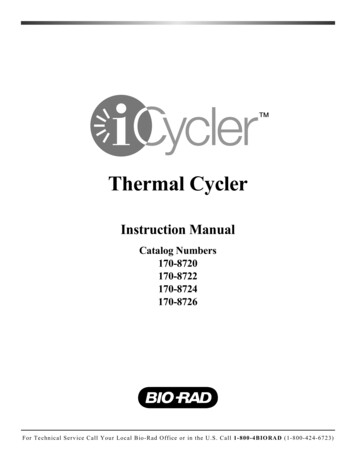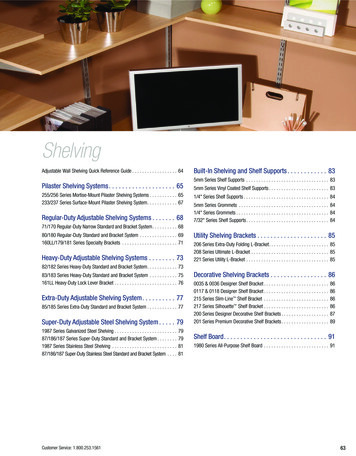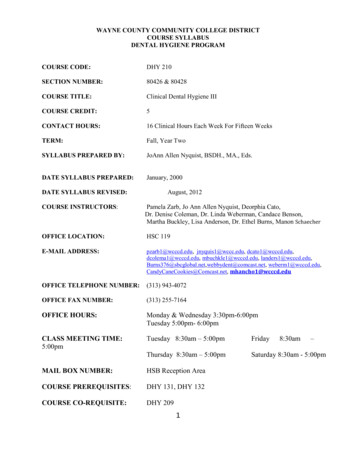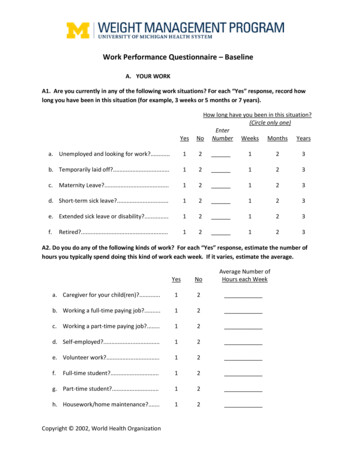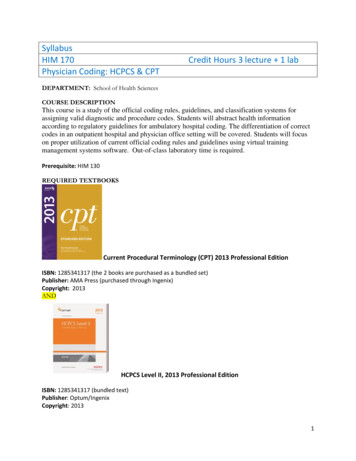
Transcription
SyllabusHIM 170Physician Coding: HCPCS & CPTCredit Hours 3 lecture 1 labDEPARTMENT: School of Health SciencesCOURSE DESCRIPTIONThis course is a study of the official coding rules, guidelines, and classification systems forassigning valid diagnostic and procedure codes. Students will abstract health informationaccording to regulatory guidelines for ambulatory hospital coding. The differentiation of correctcodes in an outpatient hospital and physician office setting will be covered. Students will focuson proper utilization of current official coding rules and guidelines using virtual trainingmanagement systems software. Out-of-class laboratory time is required.Prerequisite: HIM 130REQUIRED TEXTBOOKSCurrent Procedural Terminology (CPT) 2013 Professional EditionISBN: 1285341317 (the 2 books are purchased as a bundled set)Publisher: AMA Press (purchased through Ingenix)Copyright: 2013ANDHCPCS Level II, 2013 Professional EditionISBN: 1285341317 (bundled text)Publisher: Optum/IngenixCopyright: 20131
Basic Current Procedural Terminology/HCPCS Coding, 2013 EditionISBN # : 9781584264002Publisher : AHIMA PressCopyright : 2013Author Gail I. Smith, MA, RHIA, CCS-PKey Features Complete explanation of symbols and formatting used in CPT/HCPCS coding, providing afoundation for learning and applicationArtwork helps student visualize anatomy and related surgical procedures as they practice codingLesson on use of CPT Assistant to support coding decisionsIllustration of the connection between coding and reimbursementSkill-building exercises for every chapter, plus more than 60 additional Operative Reports inAppendix C Detailed chapters on modifiers, HCPCS Level II (National Codes), and reimbursement providetargeted learning for both hospital and physician office coding Clinical Coding Workout, without answers, 2013 EditionISBN # : 9781584264187Publisher : AHIMA PressCopyright: 2013Key Features Practice of dual coding in both ICD-9-CM and ICD-10-CM/PCS2
Coding for present on admission and MS-DRGs Subsections addressing specific body systems and diseases, providing targeted practice Case studies with multiple choice and open-ended questions that address skills at all levelsCODING DESK REFERENCE MATERIALS:ALL AVAILABLE ON THE VIRTUA LAB ENCODER SOFTWARE 3M Encoder, CPT Assistant (available on 3M Encoder).Coder’s Desk Reference (available on 3M Encoder).COURSE OBJECTIVESA. Analyze and correct errors in coding and sequencing.B. Demonstrate the steps in a coding quality study.C. Select appropriate codes within HCPCS (Levels I & II).D. Follow appropriate guidelines & procedures as they apply to CPT.E. Use of CPT codes and select appropriate codes within the specific organ system.F. Apply appropriate guidelines to the components of the billing process.G. Evaluate coding compliance initiatives and regulatory requirements.H. Interpret and apply ambulatory payment classification systems and its impact onambulatory coding and reimbursement.PERFORMANCE ASSESSMENTThe following Domains, Subdomains, and Task Competencies of the health information technologyprofession are addressed in this course. With a minimum accuracy of 76%, the student must demonstrateacceptable performance via application exercises, quizzes and exams.AHIMA Academic Domains/Sub domainsDomain 1:Health Data ManagementSubdomain 1.a: Health Data Structure, Content, and StandardsTask 1.a.1:Collect and maintain health data (such as data elements, data sets,and databases).Task 1.a.2:Conduct analysis to ensure that documentation in the health recordsupports the diagnosis and reflects the patient’s progress, clinicalfindings, and discharge status.Task 1.a.4:Verify timeliness, complete ness, appropriateness of data and datasources for patient care, management, billing reports, registries,and/or databases.Subdomain 1.c: Clinical Classification SystemsTask 1.c.1:Use and maintain electronic applications and work processes tosupport clinical classification and coding.Task 1.c.2:Apply diagnosis/procedure codes according to currentnomenclature.Task 1.c.3:Ensure accuracy of diagnostic/procedural groupings such as DRG,MSDRG, APC, and so on.Task 1.c.4:Adhere to current regulations and established guidelines in code3
Task 1.c.5:Task 1.c.7:assignment.Validate coding accuracy using clinical information found in thehealth record.Resolve discrepancies between coded data and supportingdocumentation.Subdomain 1.d: Reimbursement MethodologiesTask 1.d.1:Apply policies and procedures for the use of clinical data requiredin reimbursement and prospective payment systems (PPS) inhealthcare delivery.Task 1.d.4:Use established guidelines to comply with reimbursement andreporting requirements such as the National Correct CodingInitiative.Task 1.d.6:Ensure accuracy of diagnostic/procedural groupings such as DRG,APC, and so on.Domain 4:Information Technology & SystemsSubdomain 4.a: Information and Communication TechnologiesTask 4.a.2:Use common software applications such as spreadsheets,databases, word processing, graphics, presentation, e-mail, and soon in the execution of work processes.Task 4.a.3:Use specialized software in the completion of HIM processes suchas record tracking, release of information, coding, grouping,registries, billing, quality improvement, and imaging.RHIT Exam CompetenciesDomain 2:Coding (18%)1. Apply all official current coding guidelines2. Assign diagnostic and procedure codes based on health record documentation3. Ensure physician documentation supports coding4. Validate code assignment8. Review and resolve coding edits (i.e. correct coding initiative, outpatient codeeditor, National Coverage Determination, Local Coverage Determination,etc.)12. Validate grouper assignment (i.e. MS-DRG, APC, etc.)Domain 3:Compliance (16%)9. Evaluate medical necessity (CDMP – clinical documentation managementprogram)11. Evaluate medical necessity (Outpatient services)Knowledge Statements*3. Medicinea.Anatomy4
b.Physiologyc.Pathophysiologyd.Medical Terminologye.Pharmacology5. Abstracting*Knowledge statements are identified through other courses taken in the program, but they arefurther applied in the concepts in this courseSTUDENTS WITH DISABILITIES:Students with documented disabilities (physical, emotional, learning and/or others) who believethat they may need accommodations in this class are encouraged to contact the Coordinator forStudent Disability Services in Room 139, extension 120, as soon as possible to arrange for suchaccommodations.LIBRARY INFORMATION:Articles:As an MWCC student, you have access 24 hours a day to more than 80 LaChance Library onlinearticle databases. To get to these resources and find articles scholarly/academic journals,magazines, newspapers, reference books, and e-books, visit the Library web page,http://library.mwcc.edu, and click FIND ARTICLES. In order to access the Library’s onlineresearch databases from an off-campus location, you will be prompted to log-in with your librarybarcode number or student ID number and last name in all CAPITAL LETTERS.Books, Videos, CDs, etc.:In order to find books, videos, etc. on a topic, you will need to use the Library catalog, located onthe Library’s webpage (http://library.mwcc.edu). Look for the FIND BOOKS & MORE link.You may arrange to pick up items at either the LaChance Library or your public library.For assistance in locating articles, books or other information sources please contact us: By telephone: 1-888-884-6922 (toll free) Via email: library@mwcc.mass.edu (account is checked at least once daily at 7:30 am,Mon-Fri) Using chat: Visit the ASK A LIBRARIAN page at: http://subjectguides.mwcc.edu/ask In person, at the LaChance Library (Gardner Campus), Leominster Student SuccessCenter and the Devens Learning Center when open. Hours can be found at:http://mwcc.edu/lib/about/hours/.ACADEMIC SUPPORT CENTER INFORMATION:Tutoring: Students in need of tutorial services are encouraged to contact the Academic SupportCenter. Tutorial services are provided free of charge to enrolled students and include face-to-faceand e-tutoring (online tutoring), drop in help with math and writing, subject tutoring (sciences,business, accounting, etc.) as well as other services. If you have questions, or wish to set up anappointment, you may contact:5
Administrative Assistant, Academic Support Center, 978-630-9333.ETutoring is available to students through iConnect and provides tutoring in subjects such aswriting, math, biology, chemistry, anatomy & physiology, statistics and accounting. Assistanceis available via chat, email and also an online writing lab where students can upload drafts ofpapers and receive feedback. To see the current schedule of eTutoring ?sys 91.For information about either library or tutoring services please contact Heidi McCann, Dean ofLibrary and Academic Support Services – hmccann@mwcc.mass.edu or 978-630-9126.ACADEMIC HONESTY & PLAGIARISM:Students are responsible for knowing Mount Wachusett Community Colleges' policy onacademic honesty and plagiarism, found at es/. In sum, it is against policy to submit work with the deliberate intent to deceive or tocheat. Plagiarism is not tolerated at the College.WITHDRAWAL FROM A COURSE:You may formally withdraw from this course through the 60% point of the semester/cycle asindicated on the academic calendar – the academic calendar is posted athttp://mwcc.edu/academic/academic-calendar/. A grade of “W” will be recorded on yourtranscript. A grade of “W” will count as credits attempted but not completed, but will not impactQPA. You are required to speak to me or your assigned advisor before withdrawing from thiscourse. The procedure for course withdrawal includes getting the proper form from the AdvisingCenter in Gardner or from the receptionist at our branch campuses (Leominster, Devens,Burbank), bringing the form to me or your assigned advisor, and returning the signed form to theAdvising Center or branch campus. Please be advised that ceasing to attend a class may resultin me initiating the withdrawal from a class prior to the 60% point of the semester/cycle.Course withdrawals will not be processed after the 60% point of the semester/cycle. If you stopattending after the 60% point of the semester/cycle, you will receive an F grade. F’s are averagedinto the QPA for all students. Any withdrawal may affect progress toward degree and futureeligibility to receive financial aid. Contact the record’s office for information on your studentrecords. Administrative action Forms are available for withdrawal after the 60% point of thesemester/cycle as a result of extenuating circumstances. Student may obtain an AdministrativeAction form in the records office or online at 1/Administrative-Action.pdf. Documentation of the extenuatingcircumstance must be submitted with the form for this appeal to be reviewed.COURSE OUTLINEI.The format and application of CPT codes6
II.III.IV.V.VI.VII.VIII.IX.X.ModifiersSurgery SectionRadiology SectionPathology and Laboratory ServicesEvaluation and Management Services; describes noninvasive procedures used to diagnose and determinetreatment for patients.Medicine SectionAnesthesiaHCPCS Level II CodesBilling Procedures in Ambulatory SettingsPERFORMANCE ASSESSMENTThis course is designed to complement the AHIMA National Model Curriculum Map for HITprograms. The following Domains, Subdomains and Task competencies are addressed in this course.With a minimum accuracy of 76%, the student must demonstrate acceptable performance via labexercises, assignments, quizzes and exams.EVALUATIONCourse grade will be determined as follows:A.B.C.D.E.AssignmentsDiscussion BoardsExercisesQuizzesFinal Exam25%15%20%20%20%Grading Scale:The college uses the following grading system:Letter QualityGrade PointsA4.00A3.70B 3.30B3.00B2.70C 2.30C2.00C1.70D 1.30D1.00D0.70F0.007
Active Engagement RubricEach week, the class will focus on a given topic to discuss andinvestigate. Students will participate either through in-classdebates, or by posting discussions in the learning managementsystem. Possible grade is between 100 and 0. Below is an exampleof how student gets from F to A on active participation/coursediscussionGradeOrganization100 pointsComments are wellorganized and reflectstudent has readmaterials80 pointsComments can befollowed, but may bebased on experience orreflects responding toothersComments showstudent is trying torelate topic to weeklyreadings.60 pointsComments/participation/is disorganized or sporadicQuality ofInformationCommentsdemonstrate studentunderstands the topicinformation. Newinformation or insightsare offered.SourcesComments aresupported by one ormore referencedcitations - supportsideas with facts/quotesMay use a citation, ormakes reference topersonal workexperience to supportan ideaMakes a post but it isunsupported by citation orexperience, and is verybrief.ParticipationStudent participatesfour or more timesduring the discussionperiodStudent participates atleast twice with anoriginal comment andat least onereply/reaction toanother student.Student comments orposts once.Non-participation 0Comments drift from topic,tend to be generic and addlittle or no value to thedialogue.8
HIT 170 Course Outline (15 Modules)HIT 170Lecture Topics & ReadingsMODULE 1- Introduction to Clinical Coding- Application of the CPT SystemRead Smith CH 1: 1 – 13MODULE 2- Reimbursement in the AmbulatorySettingRead Smith CH 2:17 – 40Read Smith CH 11:261-272HIT 170Lab TopicsHIT 170Lab Assignments- How to use the Workbook, Orientation AssignmentTextbook, and the CodingBooksCH 1 Smith QuizIntroduction to ClinicalCoding- Apply terminology toidentify correct codingTopic of the Week: What isthe role of CPT Assistant inCPT coding, and where willyou find it?Working with CPT symbols CCW CH 2 Exercise Questions 2.1 –and conventions2.22 and –ReimbursementCCW CH 2 Exercise Questions 2.64 –2.90Topic of the Week: What isthe NCCI, and why do wehave it?CH 2 Smith Quiz9
MODULE 3- The Use of Modifiers- ModifiersRead Smith CH 3:41 – 51Topic of the Week: Describewhat coding for medicalCCW CH 2 Exercise Questions 2.408 –necessity means, and how it 2.427is accomplished.Graphical AssignmentCH 3 Smith QuizMODULE 4- Surgery Integumentary Musculoskeletal RespiratoryRead Smith CH 4: 53-92- Surgery (Integumentary) CCW CH 2 Exercise Questions 2.64 –- Surgery (Musculoskeletal) 2.191 and-Surgery (Respiratory)CCW CH 2 Exercise Questions 2.92 –2.122 andCCW CH 2 Exercise Questions 2.123 –Topic of the Week: Does 2.146sequencing count whenentering CPT coding on the CH 4 Smith Quiz (Part I)billing form? Give anexample.MODULE 5- Surgery Cardiovascular Digestive- Surgery (Cardiovascular)- Surgery (Digestive)Read Smith CH 4: 93 – 117Read Smith CH 4: 118 – 132MODULE 6- Surgery Urinary Male/Female ReproductiveRead Smith CH 4: 133 – 150Topic of the Week: Theplacement of the phrase“separate procedure” in thecode definition is critical tocoding – agree or disagree?CCW CH 2 Exercise Questions 2.147 –2.172 andCCW CH 2 Exercise Questions 2.173 –2.195CCW CH 2 Exercise Questions 2.196 –2.18 andCCW CH 2 Exercise Questions 2.119 –Topic of the Week: What is 2.45Unbundling and how can itaffect a practice?CH 4 Smith Quiz (Part II)- Surgery(Urinary/Reproductive)10
MODULE 7- Surgery Endocrine Nervous Eyes and EarsRead Smith CH 4: 151 - 165CCW CH 2 Exercise Questions 2.246 –2.267 andCCW CH 2 Exercise Questions 2.268 –Topic of the Week: In your 2.85 andown words, describe what a CCW CH 2 Exercise Questions 2.286 –Surgical Package is.2.328- Surgery (Endocrine)- - Surgery (Eye/Ears)CH 4 Smith Quiz (Part III)MODULE 8- Evaluation and ManagementRead Smith CH 7:193-224, 275-278MODULE 9- MedicineRead Smith CH 8: 225 – 247MODULE 10- RadiologyRead Smith CH 5: 171 – 184MODULE 11- Laboratory & PathologyRead Smith CH 6: 185 - 192- Principles ofDocumentation- Criterion for LevelingCCW CH 2 Exercise Questions 2.23 –2.43CH 7 Smith QuizTopic of the Week: Whathave you found to be mosttricky about EM coding?- MedicineCCW CH 2 Exercise Questions 2.378 –2.407Topic of the Week: Why isit important to knowCH 8 Smith Quizwhether you are coding anew or established patient?- RadiologyCCW CH 2 Exercise Questions 2.329 –2.351Topic of the Week: In yourown words, compareCH 5 Smith QuizProfessional vs. TechnicalComponents.- Lab and PathCCW CH 2 Exercise Questions 2.352 –2.377Topic of the Week: What’sthe best way to codeCH 6 Smith QuizPanels?CCW CH 2 Exercise Questions 2.44 –2.63MODULE 12- Anethesia- AnesthesiologyRead Smith CH 9: 249 – 253Topic of the Week: Give an CH 9 Smith Quizexample of QualifyingCircumstances when codinganesthesia.11
MODULE 13- HCPCS Level II CodesRead Smith CH 10: 255-259MODULE 14Reimbursement in the AmbulatorySetting- HCPCS Level II CodesCoding References AssignmentTopic of the Week: In 2003, CCW CH 2 Exercise Questions 3.1 –the rules about HCPCS Level 3.59II changed – whathappened?CH 10 Smith QuizPhysician based billing3M Coding/Grouping AssignmentRead Smith CH 11Topic of the Week: Whatare APCs and how do they CH 11 Smith Quizaffect physician revenue?MODULE 15Building Competencies & ApplyingKnowledgeDemonstrate competencyreviewing charts andselecting correct codesCode Auditing AssignmentTopic of the Week: After 15weeks of intense CPT/HCPCSpractice, are you ready tocode charts in the physicianpractice setting?Finals WeekCourse EvaluationComplete Final Exam: Ten Case Studies12
Physician Coding: HCPCS & CPT . DEPARTMENT: School of Health Sciences . COURSE DESCRIPTION . This course is a study of the official coding rules, guidelines, and classification systems for assigning valid diagnostic and procedure codes. Students will abstract health information according to regulatory guidelines for ambulatory hospital coding.


